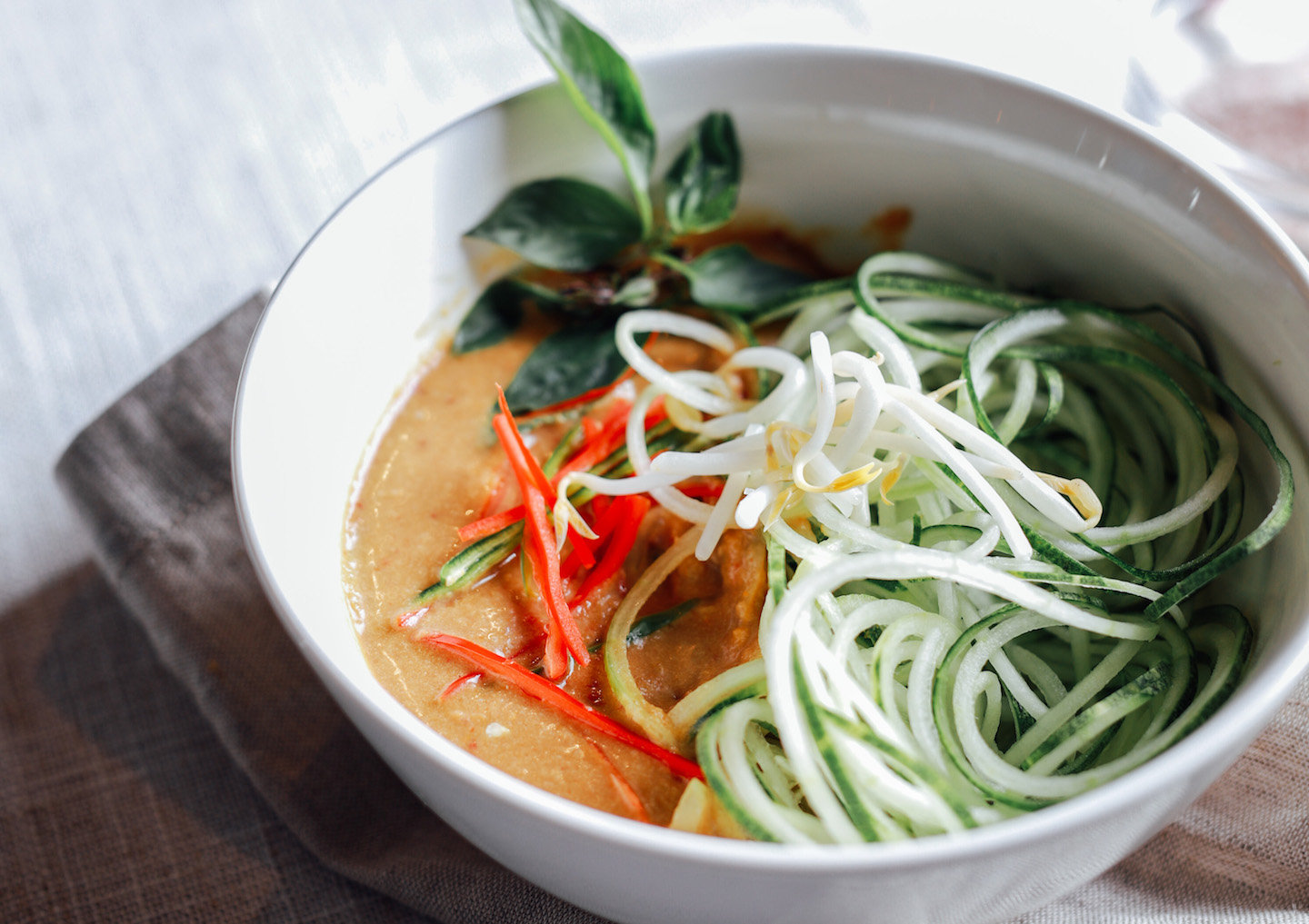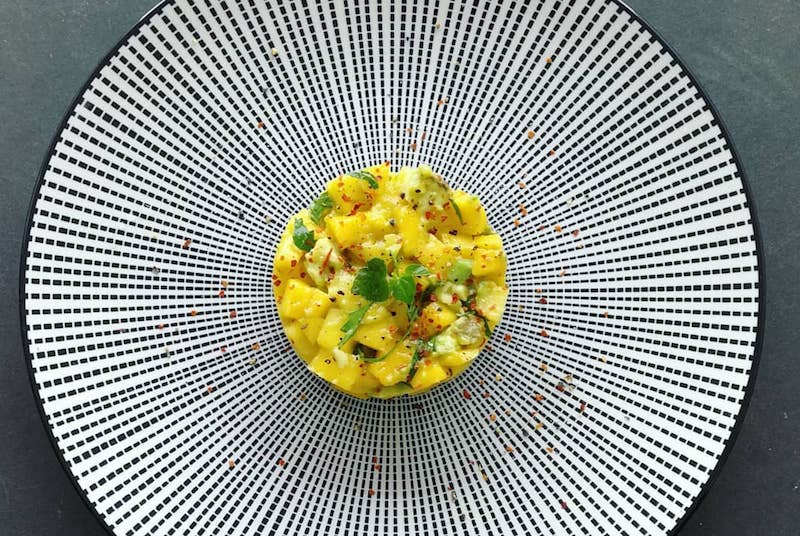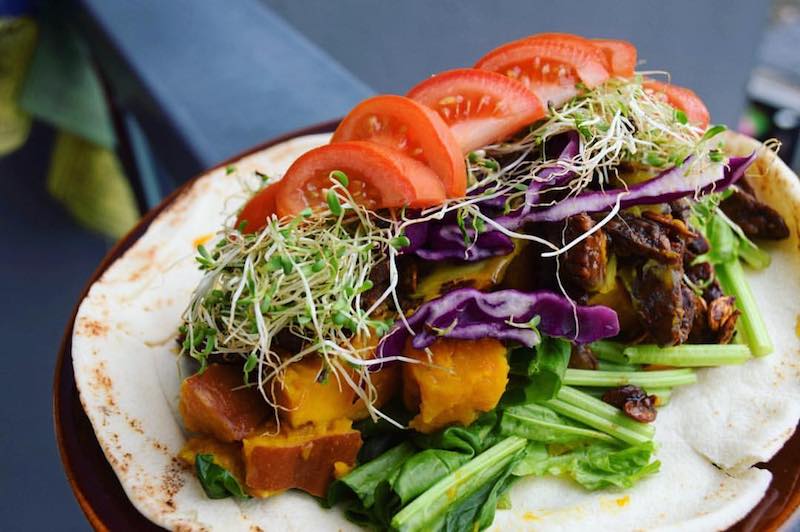
Chef Yin created this vegan laksa noodles at Ben's Independent Grocer's Masak Masak studio. (Photo: Calvin Goh/Ben's Independent Grocer)
Inspiring through her dishes
Boey Yin Yin, one of Malaysia’s most interesting raw vegan chefs, aims to inspire and encourage everyone to make healthy, energising and delicious plant-based meals. Find her recipes and book a spot in her class on rawchefyin.com.
Options: How did you get your start in the vegan food movement?
Boey: In the early 1990s, I became aware of how meat wasn’t good for our bodies from books, magazines and newspaper articles, so I started cutting out chicken, beef and lamb. I was more or less pescatarian, eating mainly vegetables and some fish/seafood. Unfortunately, I was also brainwashed by the general public telling me that I needed to have protein and thought I had to get that from fish. In 2014, I made my very first fully raw vegan meal and in 2015, I started transitioning from pescatarian to vegetarian, and then to vegan. I didn’t really know of any other raw vegans around in KL, so I started organising my own meetups. Through that, I discovered there was a small but thriving vegan community in Malaysia and have tried to support and take part in as many of their activities as I can.

Has becoming a vegan chef required a relook of your training and skills?
As a kid, I grew up on raw cucumbers, carrots and celery sticks as snacks and didn’t think it was unusual until my friends would make fun of me, calling my snacks “rabbit food” or exclaiming that I was on a “goat’s diet”. I pretty much ignored them although the name-calling hurt. For years, I would ensure that I had a small portion of raw food in my lunch and dinner because my late dad said it was good for health but it never occurred to me that I could actually make an entire meal out of raw ingredients.
It was in July 2014 when I first stumbled upon This Rawsome Vegan Life blog and I saw a recipe for a fully raw meal — raw lasagna with cashew, cheese, broccoli and sun-dried tomato pesto. It took me two hours to make the meal as compared to my usual 30-minute Chinese stir-fried lunch. But what truly surprised me was that I didn’t feel bloated, ill or lethargic after the fully raw meal.
Since then I have been on a quest to learn how to make the most awesome raw food recipes ever. I bought cookbooks, read blogs, watched raw food videos and through my research, I found out about raw vegan celebrity chef Matthew Kenney on Instagram. I was instantly attracted to the amazingly attractive photos of raw food and signed up for my first course, Everyday Raw Express. That was most probably one of the significant milestones in my raw food journey. Thanks to my instructor, I learnt how to make beverages, appetisers, soups, main meals and desserts — all raw, beautiful and absolutely delicious.
I created an Instagram account specifically for my raw food meals — documenting my journey and posting pictures that sparked a lot of curiosity among friends and even strangers. My friends were constant guinea pigs for all my raw food experiments. I even volunteered to make a four-course fully raw meal for my family Christmas dinner, where I served them Zucchini Tartare, Mushroom Nut Burgers, Durian Pie and Fig Water Kefir.
Since 2015, many friends have been asking me to run workshops on raw food but I continuously turned them down as I felt I wasn’t qualified to do so. But after completing three Matthew Kenney courses and making raw meals for 1½ years, I finally decided to embrace it all. I started conducting simple raw food workshops under the name Raw Chef Yin. I’ve been working on coming up with raw food creations with a strong Malaysian touch. We have vegetables and fruits all year round and I want to tap the local resources and teach others to really have an appreciation for local produce.
I’ve also started studying more about the local herbs and edible leaves that are found abundantly here and including them in my raw food recipes. This includes a Ciku Pudding with Dragon Fruit Coulis, a Malaysian Mango Salad Dressing and lacto-fermented Belimbing Buluh. The aim is to encourage more Malaysians to recognise the value of local ingredients rather than relying on imported ones. This is my contribution towards crafting the future of food in Malaysia. I am also now the host of my own uncooking show called Velicious With Raw Chef Yin.
In addition to my culinary academy training, which focused on food preparation, I’m also a certified raw food teacher. I’ve successfully completed the Raw Teacher Training Intensive by Karen Knowler and have demonstrated an excellent understanding of what it takes to run life-changing raw food classes to a world-class, professional standard.
In theory, vegetable-rich Southeast Asian cuisine lends itself really well to veganism but in real life, it is actually quite hard to find kosher food in this region if you’re vegan or vegetarian. How do we change that?
I find that if I do my research in advance, it’s not that difficult to find vegan food. There are apps like HappyCow - of which I am an ambassador - and GoVeggie that will help identify the vegan/vegetarian places or places that offer vegan-friendly food. I have an ongoing video series called Vegan Food Adventures with Raw Chef Yin, which are short snippets where I share where to eat vegan food wherever I go, published on YouTube, Facebook and Instagram. Many people have told me they refer to my videos to find out where to eat. Also, it’s about educating the eateries and a case of supply and demand. If we request for more vegan options, then the businesses will realise there is a demand and respond to it.
As a chef, how are you rewriting recipes to reflect the growing popularity of the plant-based lifestyle?
Thanks to my previous corporate job, I’ve had the opportunity to travel all over the world and eat a lot of really good food. I look back on those experiences, remember the tastes, textures and flavours, and set out to veganise those dishes that I so love. I’ve done intensive research on how to convert traditional recipes into vegan versions.
---
Spreading greater awareness
Vegan activist Davina Goh, who blogs at davinadavegan.com, aspires to spread awareness of the benefits and joys of a plant-based diet for a healthier Malaysia.
Options: How would you rate the health of the vegan movement in Malaysia?
Goh: It’s as healthy as the food itself! From my six years of being vegetarian and almost three years of being vegan, I have observed an exponential increase in interest among the urban community in Malaysia. The questions non-vegans ask me are evolving and becoming more complex, reflecting a greater awareness. A lot more people are identifying themselves as vegans and empowering those around them to become more conscious about the benefits the lifestyle brings. Veganism hasn’t become mainstream in Malaysia yet, but once you pop your head through the door to see what the noise is all about, the house party is jumping! It’s a very exciting thing to witness ... something even I didn’t expect to see happen so soon, and so quickly too.
How did the vegan movement gain traction here?
I think social media, especially Instagram, played a major role. Not too long ago, celebs such as Liam Hemsworth, Beyoncé and Lewis Hamilton began vocalising their preference for a plant-based diet. It also started becoming cool for people to share colourful pictures of plant-based food on Instagram. The trend has not slowed down since. In fact, in August, a report came out that veganism was currently the most popular diet on social media. It’s hard for a fairly small country like Malaysia to not become at least a little bit influenced by a situation like that!
What about our local produce that makes veganism easier to practice in our country?
It is easy for a practising vegan in Malaysia like me to see that we have always had the tools for anyone in this country to practice the lifestyle with ease. Our cuisine is famous because of how vibrant it is, with influences from the Indian, Malay, Chinese, Thai, Indonesian and Portuguese cultures. All we need to do is take these flavours and infuse them into plants instead of meat! Our fresh local produce is astonishingly diverse, plentiful, available all year round and, most importantly for Malaysians, affordable. Tempeh, one of the most sought-after plant-based protein sources in the world right now, can be bought for a little over a ringgit at the local market. Vegans in the west are paying top dollar for tropical fruits like jackfruit, mangosteen and durian, which we have easy access to. Ulam in Malaysia has always been a superfood, long before the label came into existence! These consumer options leave us spoilt for choice. Only after travelling to other countries have I realised how much we Malaysians take for granted.

At present, ‘vegan food’ seems to apply more to Western cuisine. Is there a larger effort to create more Southeast Asian vegan food?
I took the role of being a plant-based lifestyle advocate in Malaysia to help develop the much-needed Southeast Asian narrative for plant-based living. The West has quinoa, we have brown rice. The West has kale, we have kailan. A lot of friends have shared with me that their grandparents and the generations before them were mostly plant-based anyway, because they used to live off the land. We just need to make that reconnection! There are a few other individuals and organisations here with the same goal, each having a specific role to play and doing their part to broaden the local narrative and give it the global exposure it deserves.
How did you first get into the plant-based lifestyle, and how has it changed your life?
I have had a long history of discovering who I am through what I eat. Since young, I’ve loved eating vegetables a lot more than meat! It also didn’t make sense to me that I was admiring animals and eating them at the same time. My parents didn’t allow me to be vegetarian as a teenager, but what I did instead was gradually drop the meats off my diet one by one, and study everything I could about the lifestyle. When I finally made the full transition to being a vegetarian 12 years later and a vegan after that, there were no withdrawal symptoms, and I had the right knowledge and attitude to make it work for me.
I am a completely different person now. My energy levels have surged, I get sick less often and recover faster from illness. My skin has cleared up. I’m achieving physical challenges that my body wasn’t able to pull off 10 years ago. Because I have eliminated from my life all the dodgy issues that comes with eating meat, my heart and mind are clearer and more at peace. The compassion I used to practise towards animals has permeated throughout my life. I’m more compassionate towards other humans and even to myself. I’ve never been happier.
How do you develop new recipes and other content for your website?
I dine out with everyone, without judgement. When I do this, I get exposed to many more types of dishes than when I eat alone, so my inspiration to cook and try new things never wanes. It particularly helps to dine with non-vegans, shamelessly hovering over their shoulders to ogle at what they have ordered. It ignites my imagination about how I would want to achieve the same thing without meat. I also look back at the dishes I have grown up with and work on reinterpreting them today. When I develop recipes, a lot of it has to do with practice. I don’t always get it right the first time. But when you practise, you develop a familiarity with vegan ingredients and an instinct about how different ingredients might respond to each other. I stay as informed as I can with what is trending out there in the realm of veganism and healthy, eco-friendly living, to create content that may resonate within my community. My recipes, and the rest of the content on my website, are driven by sheer passion and determination to share my life-changing discovery of veganism with others, in hopes that they experience something similar for themselves.
This article first appeared on Oct 29, 2018 in The Edge Malaysia.


